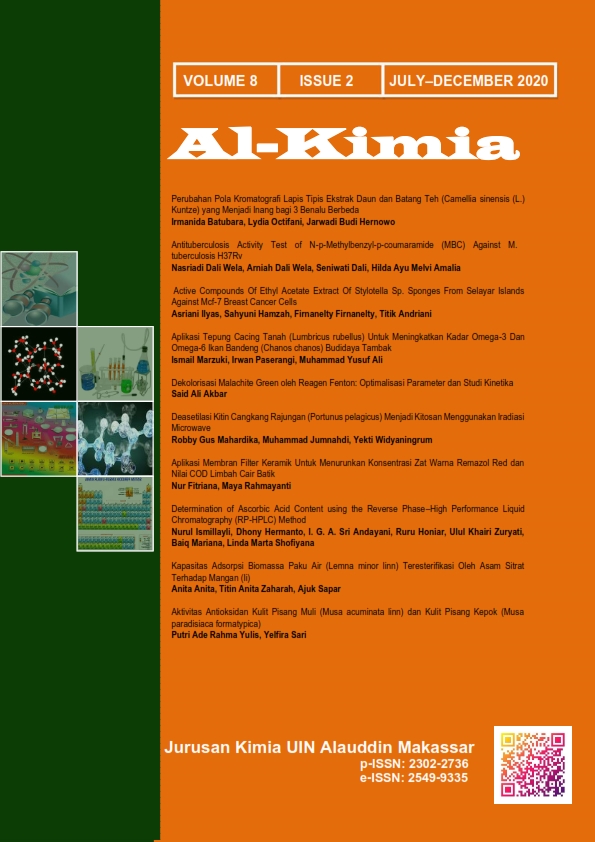Determination of Ascorbic Acid Content using the Reverse Phase–High Performance Liquid Chromatography (RP-HPLC) Method
Abstract
A method of reverse phase-high performance liquid chromatography (RP-HPLC) was evaluated in ascorbic acid determination. The determination was conducted at optimum conditions for RP-HPLC method, including ethanol as mobile phase, flow velocity of 0.8 mL/min, running time of 5 minutes, injection volume of 10 µL, UV detector, wavelength of 245 nm with internal standard of ascorbic acid in metaphosphate-acetic acid. Result of measurement was validated by AOAC Official Method 967.21. It was obtained that RP-HPLC method was high sensitive and precision method due to its limit of detection was 0,5 µg/mL and RSD was ≤ 2%. The results of the determination of vitamin C content in fresh ceruring fruit using RP-HPLC method and the titrimetry method namely, 52.9057 ± 0.17 and 54.2066 ± 0.87 mg in 100 g sample, respectively. Based on statistical analysis (t-test), there were no significant differences for the two methods used. The percentage of recovery obtained is excellent in the range of 97.9-104.3%. Therefore, the RP-HPLC method is expected to be an accurate method for routine analysis of vitamin C.
Key word: ascorbic acid, reverse phase, HPLC, titrimetric.
Downloads
References
Al Majidi, M. I. H., Y-AlQubury, H. 2016. Determination of Vitamin C (ascorbic acid) Contents in various fruit and vegetable by UV-spectrophotometry and titration methods. Journal of Chemical and Pharmaceutical Sciences, 9(4), 2972–2974.
AOAC. 2006. Ascorbic Acid in Vitamin Preparations and Juices 2,6-Dichloroindophenol Titrimetric Method, 6-7.
AOAC. 2012. Vitamin C (ascorbic acid) in Infant Formula and Adult/Pediatric Nutritional Formula by UHPLC-UV, 1–2.
Asmara, A. P., Amungkasi, H. K. 2019. Kajian Kinetika Pengaruh Lama Penyimpanan terhadap Kadar Vitamin C pada Buah Apel Malang (Malus Sylvestris). Al Kimia, 7(1), 136–146.
Aulia, S. S., Sopyan, I., Muchtaridi. 2016. Penetapan Kadar Simvastatin Menggunakan Kromatorafi Cair Kinerja Tinggi (KCKT): Review. Farmaka, 14(4), 70–78.
Bi, H., Fernandes, C. A., Cardoso, S., Freitas, P. 2016. Interference-Blind Microfluidic Sensor for Ascorbic Acid Determination by UV/Vis Spectroscopy. Sensors & Actuators: B. Chemical, 224, 668–675.
BPOM. 2016. Badan Pengawas Obat Dan Makanan Republik Indonesia Nomor 9 Tahun 2016 Tentang Acuan Label Gizi, 1-8.
Dinesh, B., Yadav, B., Reddy, R. D., Padma, A. S.,Sukumaran, M. K. 2015. Determination of Ascorbic Acid Content in Some Indian Spices. International Journal of Current Microbiology and Applied Sciences, 4(8), 864–868.
Dipahayu, D., Permatasari, S. N. 2019. Pengaruh Metode Penggerusan Tablet Vitamin C Terhadap Kadar Bahan Aktif. Jurnal Kimia Riset, 4(2), 94-99.
Du, J., Cullen, J. J., Buettner, G. R. 2012. Biochimica et Biophysica Acta Ascorbic Acid : Chemistry, Biology and the Treatment of Cancer. Biochimica et Biophysica Acta, 1826(2), 443–457.
Firdous, J., Naveed, M., Karpagam, T., Karthi, G. B., Subashini, S. R. 2011. A New Photometric Method of Vitamin C in Tomato. International Journal of Institutional Pharmacy and Life Sciences, 1(2), 66–74.
Grosso, G., Bei, R., Mistretta, A., Marventano, S., Calabrese, G., Masuelli, L., Giganti, M. G., Modesti, A., Galvano, F., Gazzolo, D. 2013. Effects of Vitamin C on Health: A Review of Evidence. Frontiers in Bioscience, 18(3), 1017–1029.
Guglu, K., Sozgen, K., Tutem, E., Ozyurek, M., Aspak, R. 2005. Spectrophotometric Determination of Ascorbic Acid using Copper(II)–Neocuproine Reagent in Beverages and Pharmaceuticals. Talanta, 65, 1226–1232.
Hasanin, T. H. A., Fujiwara, T. 2018. Flow-Injection Chemiluminescence Method for Sensitive Determination of Ascorbic Acid in Fruit Juices and Pharmaceutical Samples Using a Luminol–Flow-Injection Chemiluminescence Method for Sensitive Determination of Ascorbic Acid in Fruit Juices and Phar. Analytical Sciences, 34, 777–782.
Hermanto, D., Ismillayli, N., Honiar, R., Andayani, I. G. A. S., Mariana, B., Sanjaya, R. K. 2020. Transparent Membrane of Polyelectrolyte Complex Doped with 2,6-Dichlorophenol-Indophenol as an Optical Sensor for Colorimetric Measurements of Ascorbic Acid. Orient. J. Chem. 36(4), 680-686.
Jubahar, J., Astuti, Y., Suharti, N. 2015. Penetapan Kadar Vitamin C dari Buah Cabe Rawit (Capsicum Frutescens L.) dengan Metode Kromatografi Cair Kinerja Tinggi (KCKT). Jurnal Farmasi Higea, 7(2), 208-217.
Matsuoka, Y., Yamato, M., Yamada, K. 2016. Fluorescence Probe for the Convenient and Sensitive Detection of Ascorbic Acid. Journal of Clinical and Biochemical Nutrition, 58(1), 16–22.
Sharaa, I. El, Mussa, S. Ben. 2019. Determination of Vitamin C (Ascorbic Acid) Contents in Vegetable Samples by UV-Spectrophotometry and Redox Titration Methods and Estimation the Effect of Time , Cooking and Frozen on Ascorbic Acid Contents. International Journal of Progressive Sciences and Technologies, 15(2), 281–293.
Tu, Y. J., Njus, D.,Schlegel, H. B. 2017. A theoretical Study of Ascorbic Acid Oxidation and HOO•/O2•− Radical Scavenging. Organic and Biomolecular Chemistry, 15, 4417–4431.
Zuo, R., Zhou, S., Zuo, Y., Deng, Y. 2015. Determination of Creatinine, Uric and Ascorbic Acid in Bovine Milk and Orange Juice by Hydrophilic Interaction HPLC. Food Chemistry, 182, 242–25.
Authors who publish with this journal agree to the following terms:
1) Authors retain copyright and grant the journal right of first publication with the work simultaneously licensed under a Creative Commons Attribution License that allows others to share the work with an acknowledgement of the work's authorship and initial publication in this journal.
2) Authors are able to enter into separate, additional contractual arrangements for the non-exclusive distribution of the journal's published version of the work (e.g., post it to an institutional repository or publish it in a book), with an acknowledgement of its initial publication in this journal.
3)Authors are permitted and encouraged to post their work online (e.g., in institutional repositories or on their website) prior to and during the submission process, as it can lead to productive exchanges, as well as earlier and greater citation of published work (See The Effect of Open Access).


